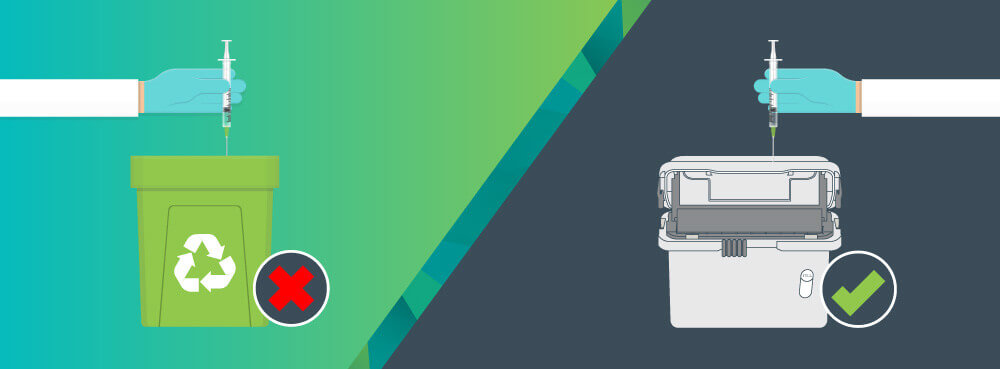Medical Waste DON’Ts

We all love simple “do’s and don’ts” lists. When looking for information of things not to do with medical waste, you might find yourself reading for a while. Daniels Health understands the standards of medical waste disposal. Let’s focus is on helping you do the right things when it comes to medical waste disposal and adopting the cradle to grave approach.
Nevertheless, a number of don’ts that come to mind are things that we often stress to medical waste generators. Some are obvious really, but you’d be surprised… Our goal is not only to keep you aware of what not to do with medical waste, but methods and solutions that minimize waste, save money, and keep you in compliance with federal and state regulations.
First though, let’s discuss just a handful of the don’ts that you should be aware of – no matter what size medical waste generator you are – clinic, veterinary office, dialysis center, cancer treatment center, or a major hospital.
Top five medical waste don’ts
 Don’t toss needles, any kind of sharps, or uncapped syringes into “regular” trash. Yes, this may seem a no-brainer, but it’s a biggie. This still happens inside the four walls of your facility. Improper sharps disposal not only contributes to risks to employees, but the general public and medical waste disposal company workers. Sharps waste must go into a proper sharps container to prevent needlestick injury or sharps injury. Reduce risk of sticks with proper sharps disposal containers and sharps container placement. A variety of sharps container options are out there (including our proprietary designs), so there’s no excuse for improper sharps disposal. It makes good sense, not only in relation to compliance, but in protecting employees against needlestick injury scenarios that cost you time and money and damage your reputation.
Don’t toss needles, any kind of sharps, or uncapped syringes into “regular” trash. Yes, this may seem a no-brainer, but it’s a biggie. This still happens inside the four walls of your facility. Improper sharps disposal not only contributes to risks to employees, but the general public and medical waste disposal company workers. Sharps waste must go into a proper sharps container to prevent needlestick injury or sharps injury. Reduce risk of sticks with proper sharps disposal containers and sharps container placement. A variety of sharps container options are out there (including our proprietary designs), so there’s no excuse for improper sharps disposal. It makes good sense, not only in relation to compliance, but in protecting employees against needlestick injury scenarios that cost you time and money and damage your reputation.
- Don’t ignore federal, state, or local health department regulations when it comes to proper labeling and packaging of medical waste. The Environmental Protection Agency (EPA) recommends checking with state guidelines for regulations regarding medical waste treatment. This includes segregation guidelines, instructions for transportation forms, proper shipment manifests, and other rules when it comes to medical waste removal and medical waste disposal processes for different waste streams. For example, regulations for medical waste generators in Ohio fall under the purview of the Ohio Environmental Protection Agency and the Ohio EPA Division of Materials and Waste Management. North Dakota’s hazardous-waste programs and regulations are found on the North Dakota Department of Health website and the North Dakota Department of Health Division of Waste Management. Size and placement of labels will differ depending on what type of waste is packaged or stored in containers. Know the laws of your state!
- Know the approved containers and methods of packaging different types of medical waste for transportation. While medical waste companies should know this about medical waste disposal, the responsibility falls on the medical waste generator. A number of guidelines apply and fall under the Department of Transportation (DOT). The EPA and DOT are very specific regarding packaging and transportation of regulated medical waste and hazardous waste transportation. If you’re not familiar with it yet, check out Code of Federal Regulations 49 CFR 173.197. You’ll find information regarding regulated medical waste that covers non-bulk packaging, sharps containers, large packaging and additional requirements, including liquid regulated medical waste. Regulations also apply to proper shipment manifests, especially in the case of hazardous waste disposal.
- Don’t ignore waste segregation! This is a big no-no when it comes to medical waste disposal. Waste segregation is vital and must continue even after you’ve identified and categorized your waste as either hazardous or non-hazardous. In failing to segregate, risks of mixing (accidentally or not) different waste streams increases. Sharps must be stored and discarded in a regulations-compliant sharps container. That means a leak-proof, spill-proof, puncture-proof container. Red bags are designed for any potential biohazard or infectious materials. Pharmaceutical waste such as pills must also be segregated and placed in their own plastic containers. When it comes to medical waste disposal transportation issues, take the time to read all of CFR 49. Avoid non-compliance issues, fines, and penalties.

- Don’t ignore or minimize employee training. Lack of proper training in medical waste is detrimental to your operations. We know you’re busy running your medical facility, but inadequate employee training leads to big problems when it comes to hazardous waste disposal, overall healthcare waste management, and healthcare waste segregation issues. One mistake by one employee can end up costing your facility tens of thousands of dollars in violations. It doesn’t matter whether that employee works in grounds- keeping, maintenance, the laundry department, or in a surgical suite. Every employee should be aware of different methods for handling a medical waste stream. This applies to anatomical waste, chemo waste, infectious waste, pathological waste, and surgical waste, among others. It’s not enough to just follow federal guidelines. Individual states are have medical waste disposal regulations that must be followed.
Compliance is essential.
Daniels Health offers clinical solutions by business type and need, as well as resources and guidance when it comes to compliance. Don’t make medical waste mistakes. Call us for solutions in education and training that enhance efficient and economical sustainability, reduces amount of waste making its way to landfills, and sharps injury reduction.
Let's Talk!
Your time is valuable, and we don’t want to play hard to get. You can either phone us directly on the details listed on our contact page, or feel free to fill out this short form and one of our team members will get back to you as quickly as possible.
